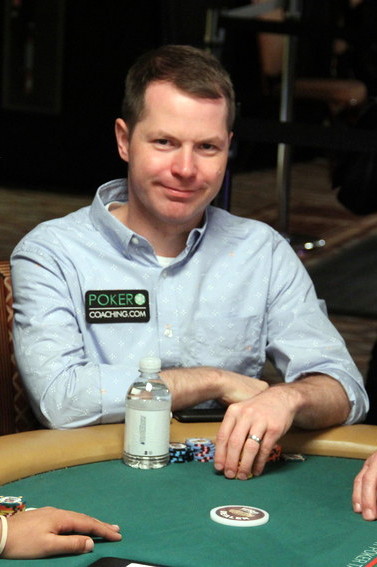






How To Play An Underpairby Jonathan Little | Published: Aug 09, 2023 |
|
|
 If you want to increase your poker skills and learn to crush the games, check out Jonathan Little’s elite training site at PokerCoaching.com/CardPlayer.
If you want to increase your poker skills and learn to crush the games, check out Jonathan Little’s elite training site at PokerCoaching.com/CardPlayer.
One of my students recently told me about a hand from a $5-$10 no-limit hold’em cash game that demonstrates exactly how you should play a marginal underpair. Although he ended up losing the pot, he played it well.
A loose, splashy player raised to $30 out of his $1000 effective stack from first position at a seven-handed table and our Hero with J J
J three-bet from the lojack to $90.
three-bet from the lojack to $90.
Calling should normally be your default play because you do not want to get four-bet off your hand, and there are lots of players yet to act. However, when facing a raise from a loose, splashy player, three-betting with a strong linear range for value is a strong adjustment because you can expect the initial raiser to call with many inferior hands, such as 8-8 and A 9
9 .
.
Only the initial raiser called. The flop came K 4
4 2
2 , giving Hero a marginal underpair. The opponent checked. The pot is $195.
, giving Hero a marginal underpair. The opponent checked. The pot is $195.
This is an excellent spot to either check or bet small. If Hero checks behind, he can easily call a turn bet and can often call a river bet, assuming he thinks his opponent will somewhat frequently bet the turn and river as a bluff.
Hero can also bet small in order to extract value from numerous worse marginal made hands, like 8-8 and A 4
4 , and also to protect against various over cards, like A-Q and Q-J. The main mistake many players make in this situation is to bet large, $100 or more, because then, they will usually only get called when they are beat.
, and also to protect against various over cards, like A-Q and Q-J. The main mistake many players make in this situation is to bet large, $100 or more, because then, they will usually only get called when they are beat.
Hero bet $40, and his opponent called.
While the $40 bet may seem exorbitantly small, it is perfectly fine. Do not feel as if you must make a bet that is at least as large as the bet you made on the previous betting round. The game is called “no-limit” for a reason. You can bet any amount, even a tiny one.
The turn was the 3 , and the opponent checked. The pot is $275.
, and the opponent checked. The pot is $275.
I am again fine with either checking or betting small, perhaps $100. I typically check in this spot, looking to call most river bets. Checking behind will ensure you do not get check-raised and also allows you to easily see the showdown, which is exactly what you want when you have a marginal made hand.
Hero checked behind. The river was the J , giving Hero a set. The opponent bet $130.
, giving Hero a set. The opponent bet $130.
At this point, Hero has the effective nuts and should raise. While it is true that he may only get called by flushes and straights if his opponent is weak and passive, given the opponent’s loose, splashy tendencies, it is safe to assume he will call a modestly-sized raise with top pair and better made hands.
Hero raised to $330 and the opponent quickly called with 9 8
8 for a flush.
for a flush.
Although Hero lost this hand, I think he played it well.
Notice that he wins this pot every time his opponent does not backdoor a premium hand. When the opponent doesn’t (about 90% of the time), Hero will either win a small pot when his opponent gives up or a medium pot when his opponent decides to bluff. This will result in Hero printing equity in the long run.
While Hero’s river value raise may seem thin, as long as you correctly assess that your opponent will call a small raise on the river with numerous inferior hands, it will make money in the long run. If your river value raises only get called by worse hands, you are not raising thinly enough.
If you want more resources to help you improve your game, I put together a course called Master the Fundamentals. This course covers the basics, preflop, post-flop, multiway, turn and river strategy, and much more. This course is completely free inside the Card Player Poker School!
When you join the Card Player Poker School (it’s free to join), you’ll also get:
✔ Free downloadable preflop charts
✔ GTO preflop charts
✔ Video Classes
✔ Interactive Hand Quizzes
✔ Free Course: Master the Fundamentals
✔ Free Course: The 25 Biggest Leaks and How to Fix Them
✔ Free training every week
 Jonathan Little is a two-time WPT champion with more than $7 million in live tournament earnings, best-selling author of 15 educational poker books, and 2019 GPI Poker Personality of the Year. If you want to increase your poker skills and learn to crush the games, check out his training site at PokerCoaching.com/cardplayer.
Jonathan Little is a two-time WPT champion with more than $7 million in live tournament earnings, best-selling author of 15 educational poker books, and 2019 GPI Poker Personality of the Year. If you want to increase your poker skills and learn to crush the games, check out his training site at PokerCoaching.com/cardplayer.
Features
Tournaments
Strategy
Commentary & Analysis